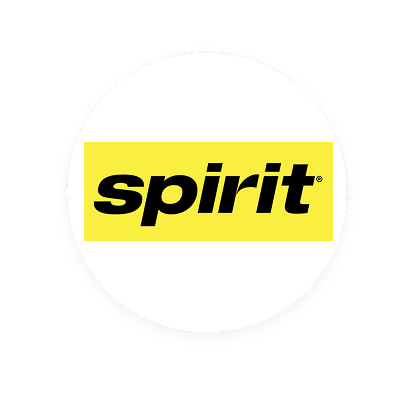60 connected apps
132 reusable APIs
Challenge
Keeping passenger journeys smooth and seamless
Spirit Airlines is a commercial airline headquartered in Florida. The company is dedicated to delivering the best value in the sky and has reimagined the air travel experience with technology. Its award-winning, innovative self-bag drop system speeds up check-in for the airline’s guests. The carrier has also received the Federal Aviation Administration’s prestigious Diamond Award of Excellence for Aviation Maintenance Technician Safety seven years in a row, showing its dedication to team member and guest safety.
Keeping an airline running smoothly relies on a vast network of processes behind the scenes, from booking tickets, handling queries, and managing customer loyalty on the commercial side, to aircraft maintenance, flight tracking, and staff management on the operational side. At every touchpoint, Spirit Airlines needs accurate real-time data.
The company needed a new integration strategy to keep operations running smoothly and digitalize more processes behind the team member and guest experience.
Objectives
Adopting an enterprise service bus architecture and shared services
Spirit Airlines decided to adopt a different type of architecture. As Rocky Wiggins, Senior Vice President and Chief Information Officer at Spirit Airlines, explained, “In an airline you have hundreds of systems that are talking to each other in near real time, sharing massive amounts of data and events. So, rather than architect hundreds of interfaces between these systems, we opted for a service bus architecture.”
As part of this project, the airline wanted to:
- Adopt a shared microservices approach.
- Implement a common API platform.
- Establish reusable APIs to speed up innovation.
Solution
Getting a holistic picture of connected applications and data
The airline became one of the earliest adopters of Anypoint Platform in the sector, citing its ease of use and compatibility with its technical objectives as deciding factors. The IT team worked with MuleSoft partner, Green Irony, to build an event-driven, API-led architecture combining MuleSoft and Microsoft Azure, before connecting core systems.
Spirit Airlines also adopted a new strategy to find common services and unlock a holistic picture of all its applications, which gave the team more insight into data flow across the company and how best to surface it. For example, the team has created a common service called ‘flight status’ which shares the same data with anyone tracking a specific flight – be it a crew member or pilot using an internal app, or one of its guests asking for a flight’s arrival time via social media, text, or webchat.
Now, MuleSoft enables vital real-time data transfer behind the guest experience before, during, and after their flight, as well as streamlining operations, loyalty, customer support, and team member experience.
Empowering team members with one app to streamline essential functions of their role
Thanks to its common API platform, Spirit Airlines equipped front-line team members with an app that offers essential functions. Flight attendants can use the app to check-in remotely when they’re on their way to work, rather than signing in on arrival. MuleSoft automatically updates the backend system to mark that the team member has started their duty period, giving colleagues visibility of which team members are working that day.
Cabin crew can also easily view their schedule and see in-depth information about flights, from onboard equipment and the route to the tail number, tracking information, and boarding time.
“MuleSoft pulls information from multiple systems and displays them in one app, so team members can see what’s happening and seamlessly plan their day,” said Sapana Patel, Vice President of Solutions Architecture at Spirit Airlines. “For example, they can select the plane they’re scheduled to work on and see information about every guest, including whether anyone has any special requirements, where loyalty members are sitting, and which guest should disembark first if they have a tight connection at the airport.”
Launching omnichannel guest service
With MuleSoft, the airline built a chatbot that allows guests to self-serve to retrieve booking information, make flight changes, add special service requests, update their baggage information, and even purchase in-flight upgrades such as Wi-Fi.
This paved the way for new channels of communication between guest care agents and guests. Spirit Airlines reused components designed for the chatbot integration to launch multi-channel customer support, empowering agents with real-time data to better serve guests across social media, SMS, the company website, and live chat.
Now, more queries are handled by the chatbot, leaving the team free to handle complex cases.
Results
Improving efficiency, resilience, and the human experience
Spirit Airlines now has a reliable API platform and high-quality, real-time data. This architecture, which includes shared services, 60 connected apps, 132 reusable APIs, and monitoring capabilities is much more efficient, and MuleSoft powers numerous apps and systems that increase efficiency, enhance the guest experience, and improve operational resilience.
“With MuleSoft, accurate and dependable data is available in real time,” said Saad Waheed, Senior Manager of Data Services at the airline. “Our ESB architecture supports both the commercial and operational side of the business, making delays and cancelations much less likely.”
The airline has also enhanced the human experience for team members and guests, and it’s gathering relevant insights to continuously enhance efficiency and satisfaction. As Patel explained: “It’s exciting to see how MuleSoft created synergy between our flight attendants, pilots and airport teams. They have up-to-date information at their fingertips to help them make the right choices now and in the future.”
The IT team also has more time for higher value tasks now that they’re not building custom integrations, and developers can work much faster with reusable APIs. They’re currently connecting more systems with MuleSoft to give customers a better experience and make life easier for employees.
For example, both gate staff and the pilot will automatically receive a notification when the aircraft door closes, thanks to MuleSoft. This will prompt them to take their next action in preparation for take-off and is one example of how MuleSoft is helping the airline eliminate more paper processes and further streamline operations.
“The success of our implementation was down to three things: creating a shared services strategy to guide our implementation and having the right people and platform in place to execute on it,” added Patel. “We involved business stakeholders from the flight crew and contact center when we were designing services to make sure they fit their needs. Between our team, MuleSoft, and Green Irony, we’ve built an amazing ecosystem for success.”





